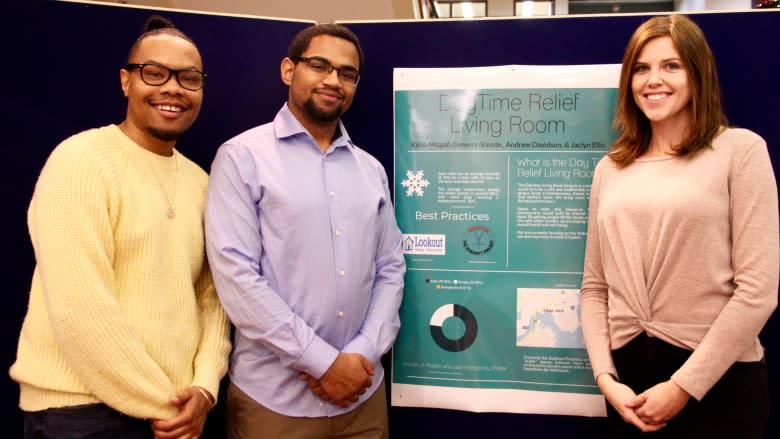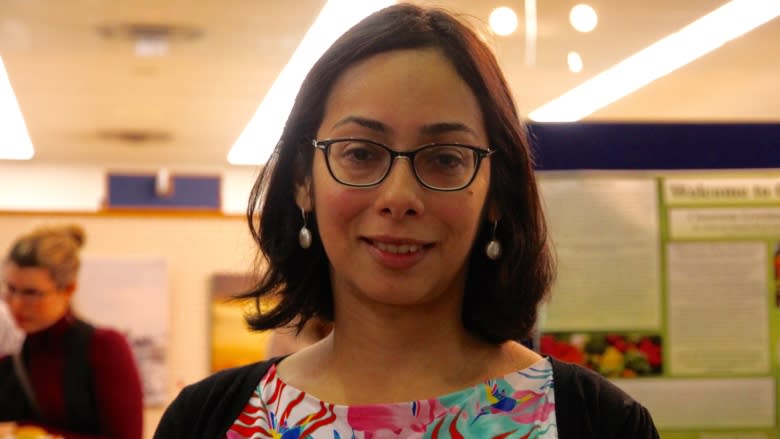Cheap thrills: Students pitch ways to make Saint John fun
Pedestrian-only streets. Food trucks. Little free libraries. Pop-up bike lanes. Guerrilla gardens.
Making a city more fun doesn't have to be expensive or involve months of planning. The idea that change can start small and be cheap — also known as "tactical urbanism" — has major appeal in Saint John, where population retention and cost-savings are perennial hot topics.
On Wednesday afternoon, politicians, not-for-profit groups, students gathered to look at "tactical urbanism" projects by students at UNB Saint John.
Winter: a major issue
Prof. Hepzibah Muñoz Martinez assigned the projects to her class, Urbanization, Poverty and Politics. She said most researchers in bigger cities have addressed "tactical urbanization in summer or spring, where there's no snow, you don't have low temperatures."
She asked her students to do something trickier: figure out innovative ways to help people enjoy public spaces in cities like Saint John that are covered much of the year in snow and ice.
Students spent the first phase of the project on field trips to the city's priority neighbourhoods, recording their observations and breaking into small groups to identify problems they wanted to solve.
Disused rinks, unhealthy food
Kjeld Mizpah Conyers-Steede, Andrew Davidson and Jacqueline Ellis came up with the Daytime Relief Living Room, which would see public spaces made available during the day on a volunteer basis to people experiencing homelessness.
Conyers-Steede said it was an illuminating experience.
"We do have issues in the community, and we can fight community issues with these small projects that create a ripple effect," he said.
"It's OK to start small."
Another group, Muñoz Martinez said, noticed how few south enders were using the skating rink in Rainbow Park. The group organized a skate exchange at the park, and discovered that most residents weren't even aware the rink existed — in part, because it lacked a shelter where people could put on skates.
"The students found that if the rink could be properly supported, it would draw people not just from the south end, but from other places in the city," Muñoz Martinez said.
Another project, Share Repair, aims to give a boost to bike trails, installing kits with free repair tools and maps in strategic locations on the Harbour Passage. Students have already designed a prototype kit, she said, which they plan to install in the near future.
The Green Hub, by students Emily Fox, Kayla Freeze and Ryan Mullet, would see greenhouses installed in schools in priority neighbourhoods.
"The idea is that we can start a pilot program which will allow children in the south end to have more contact to green space, and also learn how to grow food," said Mullet. The food could then be used to feed students, or donated to local food banks.
Small cost
Muñoz Martinez said the projects are intended to show what it's possible to achieve at a relatively low cost.
"Especially in cities, which are struggling to have resources," she said, "these projects can show … what a positive difference small interventions can make."
The research posters will be displayed at the public library for 10 days, then posted on the UNB Saint John website.
Graeme Stewart-Robertson, executive director of the non-profit Atlantic Coastal Action Program Saint John, called the projects "incredibly exciting."
"Students aren't just working on conceptual ideas, but they're actually trying to implement them."
The lesson Is that "it's not all about top-down government spending, big infrastructure or private investment," he said.
"It's about what a community can do for itself."






